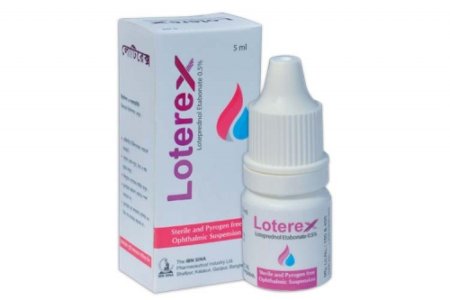
Type:5ml drop
Generic Name:Loteprednol Etabonate 0.5% Eye prep
Manufacturer:The Ibn Sina Pharmaceutical Ind. Ltd.
Price:৳175.00
Allergic conjunctivitis, Ocular inflammation
Ophthalmic Steroid-Responsive Inflammatory Conditions Indicated for the treatment of steroid-responsive inflammatory conditions of the palpebral and bulbar conjunctiva, cornea, and anterior segment of the globe (eg, allergic conjunctivitis, acne rosacea, superficial punctate keratitis, herpes zoster keratitis, iritis, cyclitis, selected infective conjunctivitides) Adult: Eye drops: Apply 1-2 drops into conjunctival sac of the affected eye(s) QID; if necessary, may increase dose up to 1 drop every hour during initial treatment within the first week Re-evaluate if signs and symptoms do not improve after 2 days Postoperative Ocular Inflammation Adult: Eye drops: Apply 1-2 drops into the conjunctival sac of the operated eye(s) QID beginning 24 hr after surgery and continuing throughout the first 2 weeks of the postoperative period Eye Ointment: Apply small amount (0.5-inch ribbon) into conjunctival sac(s) QID beginning 24 hr after surgery and continue throughout the first 2 weeks of the postoperative period
Safety and efficacy not established
Lotepro is also contraindicated in individuals with known or suspected hypersensitivity to any of the ingredients of this preparation and to other corticosteroids. Viral infections of the cornea and conjunctiva; mycobacterial eye infection; fungal infections of ocular structures.
Loteprednol is a synthetic nonfluorinated glucocorticoid. It stimulates the production of lipicortins, proteins that modulate the activity of prostaglandins and leukotrienes.
May mask and exacerbate existing ocular infection. Re-evaluate patients if symptoms do not improve after 2 days. Glaucoma; may delay healing after cataract surgery. Monitor intraocular pressure (prolonged use).
Local reactions (e.g. blurred vision, burning, itching, dry eye), photophobia, headache, rhinitis, pharyngitis. Prolonged use may increase IOP, which may be associated with possible development of glaucoma and infrequent optic nerve damage; posterior sub-capsular cataract formation and perforation of the globe where there is thinning of the cornea or sclera.